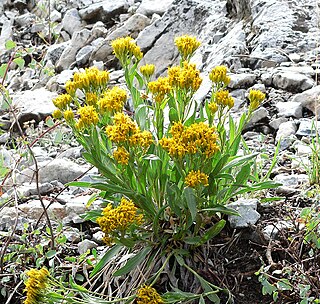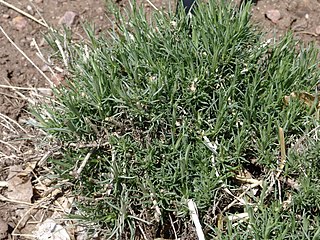
Rudbeckia is a plant genus in the Asteraceae or composite family. Rudbeckia flowers feature a prominent, raised central disc in black, brown shades of green, and in-between tones, giving rise to their familiar common names of coneflowers and black-eyed-susans. All are native to North America, and many species are cultivated in gardens for their showy yellow or gold flower heads that bloom in mid to late summer.

Chrysothamnus, known as rabbitbrush, rabbitbush, and chamisa, are a genus of shrubs in the family Asteraceae. The native distribution is in the arid western United States, Canada, and northern Mexico. It is known for its bright white or yellow flowers in late summer.

Rabbitbrush is a common name for shrubs, principally of the western United States, in three related genera of the family Asteraceae:

Astereae is a tribe of plants in the family Asteraceae that includes annuals, biennials, perennials, subshrubs, shrubs, and trees. Plants within the tribe are present nearly worldwide divided into 170 genera and more than 2,800 species, making it the second-largest tribe in the family behind Senecioneae. They are found primarily in temperate regions of the world.

Ericameria nauseosa, commonly known as Chamisa, rubber rabbitbrush, and gray rabbitbrush, is a North American shrub in the sunflower family (Aster). It grows in the arid regions of western Canada, western United States and northern Mexico.
Cuniculotinus is a genus of flowering plants in the family Asteraceae.
Lorandersonia, commonly called rabbitbush, is a genus of North American flowering plants in the family Asteraceae.

Nestotus is a genus of flowering plants in the family Asteraceae.

Stenotus is a genus of flowering plants in the family Asteraceae. There are four species, all native to western North America. They are known commonly as mock goldenweeds.
Toiyabea is a genus of North American plants in the aster tribe within the daisy family. The genus is named for the Toiyabe Mountains in the US state of Nevada. The only known species is Toiyabea alpina, the alpine serpentweed, native to the Toiyabe and Toquima Mountains of central Nevada.
Tonestus, common name serpentweed, is a genus of North American flowering plants in the family Asteraceae.

Petradoria is a genus of North American subshrubs in the tribe Astereae within the family Asteraceae.
The flora of the Colorado Plateau and Canyonlands region of the Western United States.

Chrysothamnus stylosus, called pillar false gumweed, or resinbush, is a species of flowering plants in the tribe Astereae within the family Asteraceae. It is native to Arizona and Utah in the southwestern United States.
Lorandersonia baileyi, is a North American species of flowering plants in the tribe Astereae within the family Asteraceae. It was initially discovered in the Guadalupe Mountains of New Mexico in 1902, and has since been collected in Arizona, Utah, Colorado, Kansas, Oklahoma, Texas, Chihuahua, Coahuila, and Nuevo León.

Chrysothamnus greenei, called Greene's rabbitbrush , is a North American species of flowering plants in the tribe Astereae within the family Asteraceae. It has been found in eastern California, Nevada, Arizona, New Mexico, Utah, Colorado, and southern Wyoming.
Chrysothamnus vaseyi, called Vasey's rabbitbrush, is a North American species of flowering plants in the tribe Astereae within the family Asteraceae. It has been found in Utah, Colorado, northern New Mexico, southern Wyoming, northern Arizona and eastern Nevada.
Ericameria arizonica is a North American species of flowering shrub in the daisy family known as Arizona goldenbush or Grand Canyon goldenweed. It has been found only on the cliffs on the south rim of the Grand Canyon in Coconino County, Arizona.
Ericameria winwardii is a rare North American species of flowering plants in the daisy family. It has been found only on in two adjacent counties in the western United States: Lincoln County in Wyoming and Bear Lake County in Idaho.









